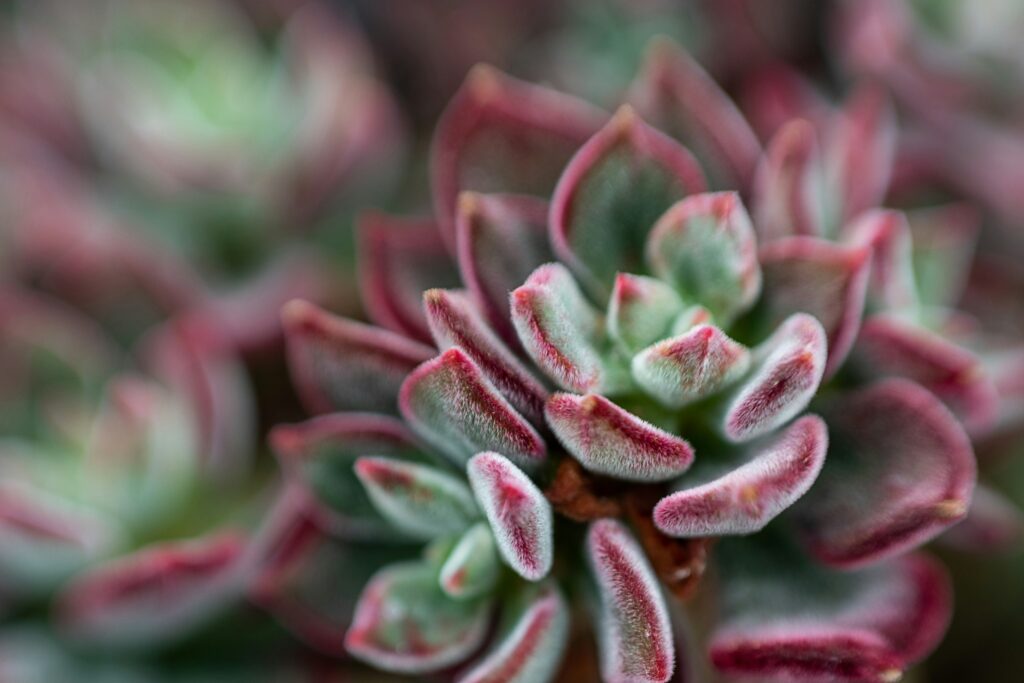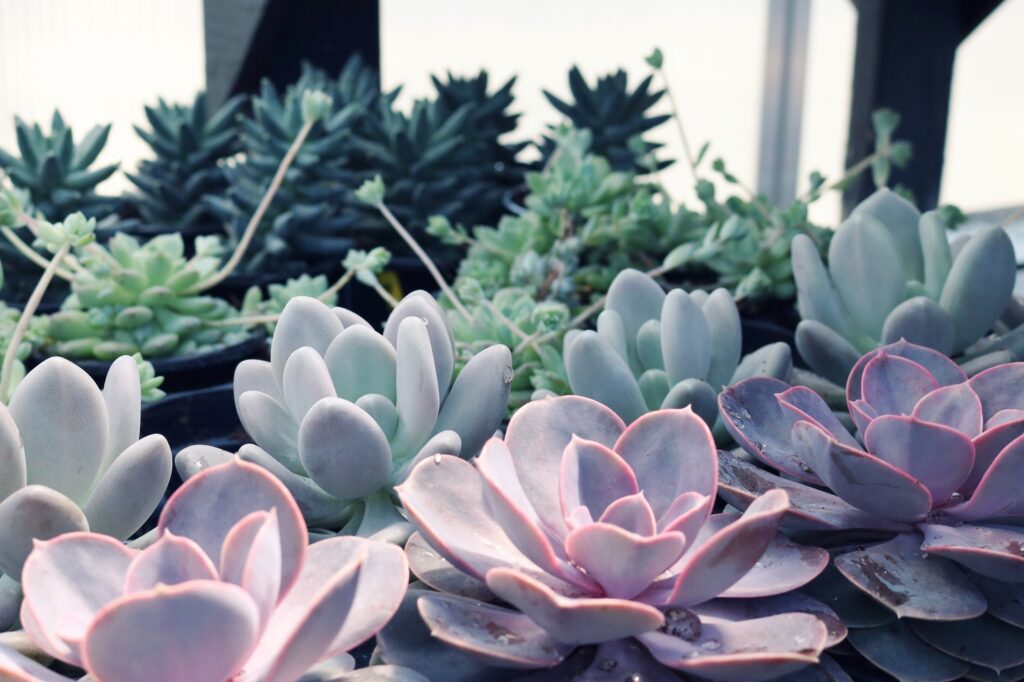Dusty Rose Succulent
The idea that generally comes to mind when the word “succulent” is used is something sumptuous, meaty, and juicy that one can just sink their teeth into.
Although you are entirely correct, a succulent in botany may not be the best thing to bite into, regardless of how delicious it may be. The countless ways these succulents display themselves throughout the year in response to light, season, temperature, soil, and hydration are a part of what makes them so fascinating.
What Exactly Are Succulents?
Succulent plants, also called succulents in botany, are plants that have adapted to dry, arid settings and are drought-resistant. They appear plump because they store water in their leaves, stems, and roots, and they flourish in neglected and dry soil.
The majority of succulents are indigenous to deserts or areas with a semiarid season and have deep or wide root systems. Many succulents are widely cultivated as ornamental and indoor plants, including Aloe, Echeveria and Kalanchoe, to name a few, while others have various non-decorative uses.
Succulents are members of the large plant family Aizoaceae, some of which are the Cactaceae and the Crassulaceae. Some cactus species are grown for food, fuel, traditional medicine, and as forage for cattle (after the spines have been removed, of course), and although all succulents are cacti, not all cacti are succulents.
Echeveria ‘Dusty Rose’ Succulent
-

madison inouye, pexels, 1117276.jpg
This Crassulaceae family’s little hybrid succulent Echeveria ‘Dusty Rose’ is well-known for its distinctive look, which resembles a rose. It is a stunning succulent that grows in rosettes of powdered pinkish-violet leaves with pink borders, and when cultivated in direct sunlight, the wide, spatulate leaves’ pink and violet hues deepen.
The ‘farina’ powder on the foliage gives the plant an iridescent sheen, enables it to withstand full daylight conditions, and causes it to become even more intense and vibrant.
‘Dusty Rose’ succulents, despite being slow to offset, send up tall bloom stalks from which hang coral, bell-shaped flowers. The rosettes eventually coalesce into striking clusters and can freely extend out to a diameter of up to 8 inches (20 cm). Strong light enhances the coloring of the leaves, which have more noticeable pink margins and change color with temperature to create a distinctive appearance.
The rosettes produce tall stalks in the spring and summer, which hang bell-shaped, eye-catching coral pink blooms.
Origins Of The Echeveria
In the 19th century, a botanist named Antasio Echeveria discovered the Echeveria succulent; however, the ‘Dusty Rose’ hybrid was developed by a succulent artist called Renee O’Connell.
The genus Echeveria contains over 150 species that are indigenous to regions of Mexico, Central America, and South America.
Characteristics Of the ‘Dusty Rose’ Succulent
- Echeveria, often known as “Mexican Hens and Chicks,” has the capacity to produce extra offsets, or “chicks,” on close stolons. and close to the mother plant.
- These chicks can be left to form a neat cluster or removed and transplanted.
- This succulent enjoys temperatures between 13 and 24 degrees Celsius, or an average of 55 to 75 degrees Fahrenheit, during the winter, and in the summer, the Dusty Rose favors temperatures between 18- and 80-degrees Fahrenheit.
- Succulents won’t withstand a hard freeze, so if there is a danger of cold weather, bring your succulent inside to grow on a sunny window sill or underneath a grow light.
- Like all succulent plants, Dusty Rose has developed a storage hoarding cell structure that functions like a sponge to absorb water while it is there and store it for use during dry periods.
- The growth location of the succulent can be determined by the size of the leaves. Higher elevations are typically home to succulents with smaller leaves.
Growing Echeveria ‘Dusty Rose’
The Planting Period: Early Spring to Late Winter
The easiest methods of propagating Echeveria include seed, leaf cuttings, and pup division. Plants need a warm, sunny site with well-drained soil to develop their leaf color, so they should be planted where they will get some shade.
Accordingly, the Dusty Rose should be exposed to sunlight in the morning, the afternoon, or both (but it should be protected from the sun during the searing heat). Plants can also be grown below full, filtered light using shade cloth, which is normally accessible at any nearby hardware store.
It is advised to use 50% filtration to prevent sunburn and maintain outstanding color but you may need to experiment to see what works best in your region. The majority of Dusty Rose succulents may thrive in pots and containers; nevertheless, they require a good drainage medium.
Simply amend the soil with some coarse grit, such as perlite or pumice, then repot in late spring each year. When repotting, don’t be concerned about causing damage to the origins because most Echeveria often handle disturbances well.
Flowering:
Early Spring to Late Winter
Echeveria has numerous flowering cycles throughout the year. Since flowering can consume a lot of a plant’s energy, it is advised to remove flower stalks from ill or weaker plants until they are set firmly in the soil.
Compact rosettes of the fleshy, frequently vividly colored leaves of succulents develop into flowers on short stalks known as cymes. If your plant is healthy, take pleasure in its lovely display of blooms because species are polycarpic, which means they may flower and set seed numerous times over the course of their existence and actually a number of times per year.
How to Grow Echeveria ‘Dusty Rose’ From Leaf Cuttings
Gently remove a leaf from the plant while propagating dusty roses with leaves. The propagation will proceed smoothly if the leaf is healthy and has completely detached from the stem.
Use well-draining soil for your new succulent plant and wait a few days for it to calluse before replanting. Don’t forget to water the plant when the soil becomes dry.
How to Grow Echeveria ‘Dusty Rose’ From Offset
The Dusty Rose can be replicated from offsets, but you may need to wait a few years for the mother plant to produce an offset before you can multiply from it. Take an offset from the main plant and use a sharp knife to begin this process.
Clean the excess soil off the offset after removing it, then wait a few days for it to settle before replanting. For your new succulent plant, choose well-draining soil and remember to water it if the soil becomes dry.
Extra Advice for Growing a Dusty Rose Succulent
- Depending on its size, one can water the plant once every seven to ten days; however, one should take care to water the plant by hydrating it as needed and pouring the water directly into the soil rather than spraying it on the leaves.
- Succulents require porous, well-draining soil to survive and stay healthy so never allow water to sit in the rosette because doing so might lead to rot or a fungal illness that will destroy the plant.
- As the plant develops, remove any dead leaves from the bottom of the plant since mealy bugs are prone to attacking Echeverias, and these dead leaves serve as a shelter for pests.
Benefits of ‘Dusty Rose’ succulents
- The ‘Dusty Rose’ is an excellent source to bring positive energy into one’s life since they have the capacity to preserve the sun’s spiritual energy.
- If you frequently forget to water your plants, the “Dusty Rose” is for you because they are hardy and need little to no care to thrive.
- They have a relaxing, beneficial influence on people, promoting better sleep quality, lowering the occurrence of anxiety attacks, and curing insomnia.
- Because they can keep oxygen flowing when you switch out the lights at night, it is highly advised that you offer these night-shift oxygen-producing indoor plants a cozy position inside your bedroom.
- They function as organic air purifiers, clearing the air we breathe of dangerous contaminants.
- They have a reputation for lowering systolic blood pressure, which in turn lessens anxiety, pain, and exhaustion and speeds up the healing process for invalids.
- They maintain interior humidity by dispersing moisture vapor, which helps to prevent bothersome respiratory conditions including a sore throat, allergies, colds, a dry cough, and even dry skin. The spread of the flu and other viruses is also halted by humidity and effective indoor air circulation.
- Based on considerable research, they help one become more creative and concentrated. ·
What better indoor plant may grace your office than the lovely “Dusty Rose” succulent?
It is no secret that people also perform their work outputs more accurately and effectively when they are around plants or in nature.
- Because succulents are known for their sustainability, as opposed to flowers and the majority of plants, which tend to wither quickly, these gorgeous plants often make excellent gifts. As unusual as it may sound to you, giving someone a gift that develops over time, like your love for them, is pretty interesting.
- Succulents don’t require special maintenance, so your loved one will appreciate having a plant that thrives with minimal attention.
Note: Be sure to place your Dusty Rose succulent in an area of your home that receives the most natural or artificial light, or at least some indirect sunlight. or partial shade for at least 4-6 hours daily.
conclusion
Succulents add more positive energy to any environment they find themselves in. They add positive vibes while purifying the environment with their distinctive and beautiful aesthetics, adding mesmerizing beauty to a place.
In addition to all the benefits of the “Dusty Rose,” these succulents have incredible symbolism and meaning. A ‘Dusty Rose’ succulent symbolizes power, persistence, and warmth.
Often seen as a representation of perseverance, strength, and selfless love, they can be used as ornaments in a garden, on one’s window sill, as a bedside plant, as a gift for a loved one’s special day, a random celebration, or for no reason at all. A dusty rose is the ideal gift that grows.




